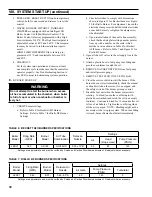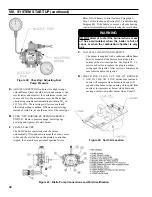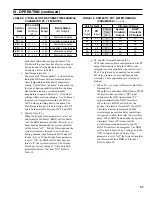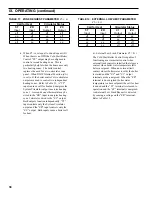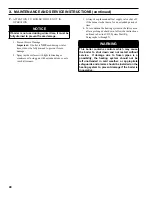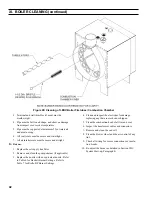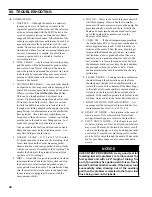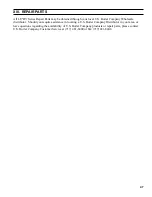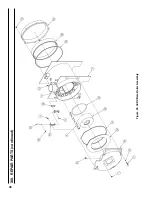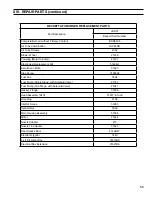
44
XII. TROUBLESHOOTING
A.
COMBUSTION
1. NOZZLES — Although the nozzle is a relatively
inexpensive device, its function is critical to the
successful operation of the oil burner. The selection
of the nozzle supplied with the LEDV boiler is the
result of extensive testing to obtain the best flame
shape and efficient combustion. Other brands of the
same spray angle and spray pattern may be used but
may not perform at the expected level of CO
2
and
smoke. Nozzles are delicate and should be protected
from dirt and abuse. Nozzles are mass-produced and
can vary from sample to sample. For all of those
reasons a spare nozzle is a desirable item for a
serviceman to have.
2. FUEL LEAKS — Any fuel leak between the pump
and the nozzle will be detrimental to good combus-
tion results. Look for wet surfaces in the air tube,
under the ignitor, and around the air inlet. Any such
leaks should be repaired as they may cause erratic
burning of the fuel and in the extreme case may
become a fire hazard.
3. SUCTION LINE LEAKS — Any such leaks should
be repaired, as they may cause erratic burning of the
fuel and in extreme cases may become a fire hazard.
Whatever it takes,
The Oil Must Be Free of Air
.
This can be a tough problem, but it must be re-
solved. Try bleeding the pump through a clear tube.
There must be no froth visible. There are various
test kits available to enable you to look at the oil
through clear tubing adapted to the supply line at the
pump fitting. Air eliminators are on the market that
have potential. Also, electronic sight glasses are
being used with good success. At times, new tubing
must be run to the tank or new fittings put on. Just
make sure you get the air out before you leave.
Any air leaks in the fuel line will cause an unstable
flame and may cause delayed ignition noises. Use
only flare fittings in the fuel lines.
4. GASKET LEAKS — If 11.5 to 12.5% CO
2
with a
#1 smoke cannot be obtained in the breeching, look
for air leaks around the burner mounting gasket,
observation door, and canopy gasket. Such air leaks
will cause a lower CO
2
reading in the breeching. The
smaller the firing rate the greater effect an air leak
can have on CO
2
readings.
5. DIRT — A fuel filter is a good investment. Acciden
-
tal accumulation of dirt in the fuel system can clog
the nozzle or nozzle strainer and produce a poor
spray pattern from the nozzle. The smaller the firing
rate, the smaller the slots become in the nozzle and
the more prone to plugging it becomes with the
same amount of dirt.
6. WATER — Water in the fuel in large amounts will
stall the fuel pump. Water in the fuel in smaller
amounts will cause excessive wear on the pump, but
more importantly water doesn’t burn. It chills the
flame and causes smoke and unburned fuel to pass
out of the combustion chamber and clog the
flueways of the boiler.
7. COLD OIL — If the oil temperature approaching
the fuel pump is 40°F or lower, poor combustion or
delayed ignition may result. Cold oil is harder to
atomize at the nozzle. Thus, the spray droplets get
larger and the flame shape gets longer. An outside
fuel tank that is above grade or has fuel lines in a
shallow bury is a good candidate for cold oil. The
best solution is to locate the tank near the boiler in
the basement utility room or bury the tank and lines
deep enough to keep the oil above 40°F. Check
environmental issues with local authorities having
jurisdiction.
8. FLAME SHAPE — Looking into the combustion
chamber through the observation port, the flame
should appear straight with no sparklers rolling up
toward the crown of the chamber. If the flame drags
to the right or left, sends sparklers upward or makes
wet spots on the target wall, the nozzle should be
replaced. If the condition persists look for fuel leaks,
air leaks, water or dirt in the fuel as described above.
9. HIGH ALTITUDE INSTALLATIONS — Air
openings must be increased at higher altitudes. Use
instruments and set for 11.5 to 12.5% CO
2
.
10. START-UP NOISE — Late ignition is the cause of
start-up noises. If it occurs recheck for electrode
settings, flame shape, air or water in the fuel lines.
11. SHUT DOWN NOISE — If the flame runs out of
air before it runs out of fuel, an after burn with noise
may occur. That may be the result of a faulty cut-off
valve in the fuel pump, or it may be air trapped in the
nozzle line. It may take several firing cycles for that
air to be fully vented through the nozzle. Water in the
fuel or poor flame shape can also cause shut down
noises.
NOTICE
CHECK TEST PROCEDURE. A very good test for
isolating fuel side problems is to disconnect the
fuel system and with a 24" length of tubing, fire
out of an auxiliary five gallon pail of clean, fresh,
warm #2 oil from another source. If the burner runs
successfully when drawing out of the auxiliary
pail then the problem is isolated to the fuel or fuel
lines being used on the jobsite.
Содержание LE DV Series
Страница 5: ...5 I General Information Figure 1A LEDV Packaged Water Boiler with Beckett AFII Burner ...
Страница 6: ...6 I General Information continued Figure 1B LEDV Packaged Water Boiler with Riello BF Burner ...
Страница 19: ...19 v venting continued Figure 11 Vent Installation Figure 12 Vent Connector Un Assembled ...
Страница 20: ...20 v venting continued Figure 13 Vent Connector Assembled Figure 14 Air Intake Installation ...
Страница 48: ...48 xiii Repair Parts continued Figure 29 LEDV Bare Boiler Assembly ...
Страница 50: ...50 xiii Repair Parts continued Figure 30 LEDV Boiler Jacket Insulation ...
Страница 55: ...55 xiii Repair Parts continued Figure 33 Vent Kit Repair Parts ...
Страница 60: ...60 U S Boiler Company Inc P O Box 3020 Lancaster PA 17604 1 888 432 8887 www usboiler net ...

